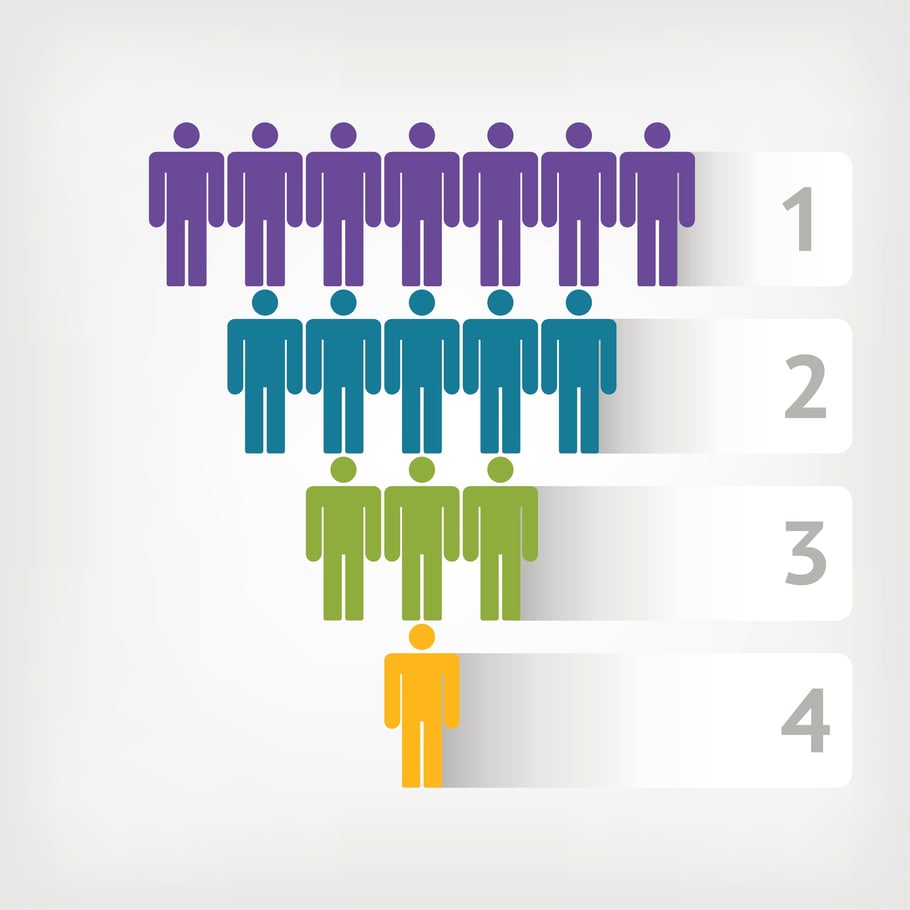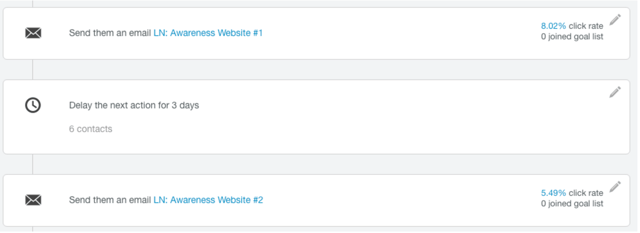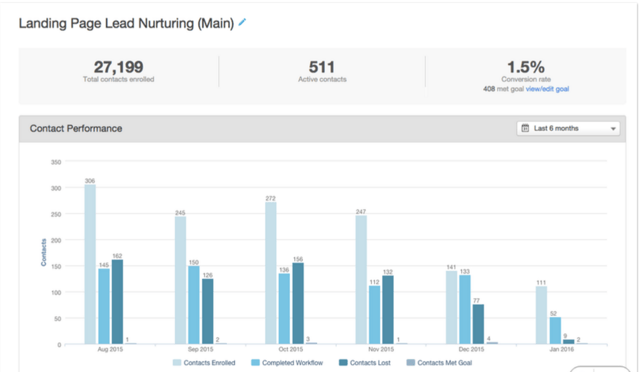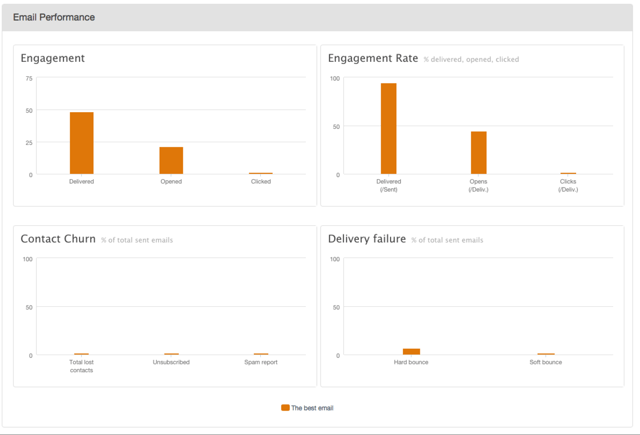
Your Inbound Leads Are Stuck in the Funnel: Now What?
August 31, 2016
By Andrew Macey
 If you’ve ever launched an inbound marketing campaign, you know how much time and effort go into making sure everything is planned out, set up, optimized, and revised before that big launch day. If you’re in a role such that organization that relies on the marketer to get you leads, then you are probably all too aware of that feeling that the process should be able to speed up.
If you’ve ever launched an inbound marketing campaign, you know how much time and effort go into making sure everything is planned out, set up, optimized, and revised before that big launch day. If you’re in a role such that organization that relies on the marketer to get you leads, then you are probably all too aware of that feeling that the process should be able to speed up.Everyone who is part of this process wants the same thing: inbound leads, marketing qualified leads, sales qualified leads, and the all-too-important customer. These leads are very important to the marketer involved, because they allow the marketer to continue gathering valuable information based on the actions taken by these leads as well as proving ROI for their services. These prospects who have found your landing page have got enough value in the offer to give you the information you asked for. In turn, they are starting to increase their qualification, have proven to you (through their initial actions) that your content is worthwhile, and are willing to leave the door open for more communication from you.
However engaged these inbound leads initially were, often they become stuck in the sales funnel. The effects of this are felt across the organization. Marketers are generating many awareness-stage leads, however these leads are not converting towards sales. Additionally, the sales pipeline is drying up as new leads are not becoming sales-qualified. In order to hit both marketing and sales targets, this process needs to be optimized.
What IS “stuck in the funnel"?
When a lead is stuck in the funnel, it means that they are not progressing towards sales. No matter which lead nurturing workflow they are enrolled in or progressive forms they interact with, they are not budging. The issue with this is as a marketer, you are left without much information. These leads have expressed interest in your company and your content at one point, however they have not requested a sales conversation. There leaves a lot to be hypothesized; for example: what their timeline is, what their pain points are, if they are the right contact, etc.Due to the influence that these leads have across your organization, it is important to clear this blockage within your sales funnel. Until this is improved, any new leads generated will not efficiently move towards sales and many will continue to get hung up. When planning to tackle this issue, you should ask yourself a few questions to confirm where the problems lie. For each stage of the funnel ask yourself:
- What should be happening?
- What is happening?
- What is not happening?
The first step in optimizing and fixing your funnel is determining if there are indeed areas where growth and/or interest seem to stop.
Assess your individual funnel by thinking through the buyer’s journey for your targeted persona. In the awareness stage, does your offer speak the language of the persona? Does the offer help them identify a problem they may not have known they had before, but will seem pressing enough for them to act on?
Is the awareness offer landing page converting visitors? If the conversion percentage is not up to par, you will want to review the landing page for best practices. One fix if you aren’t receiving adequate conversions on this page is to create an A/B test and make one version have much less copy and more keywords and phrases that the persona would recognize and use, as well as more visuals. When a visitor converts on a form, are they receiving a follow-up email, and what does their engagement look like?
Are the click rates at a reasonable percentage within the lead-nurturing emails?
(Reasonable is, of course, subjective.)

Before moving onto the next stage of the funnel and assessing for areas of improvement, ask yourself if there is anything that you expected to happen in this stage that is not happening. Did you expect a lot of activity from an initial email blast, but your conversions and visits come mostly from social channels? Did you expect tons of prospects to instantly want the offer, but no one seemed to?
If everything seems to be all right in the awareness stage, and it does not seem that the gap/blockage in the funnel is happening at that stage, follow the above steps for assessing the landing page and follow-up/lead-nurturing emails in the consideration and decision stage of the buyer’s journey in order to determine if they are doing what they are supposed to.
Examine how email and email automation are being used at each stage.
What do email stats look like? Does email seem like a valuable channel for this campaign? Is “Lost Contacts” a column that continues to climb? (If so, worry.)
HubSpot has a fantastic guide to gauging your workflow’s performance.
Fix: Extend or shorten the steps in the workflow based on when people are dropping off.
Are your leads engaging in any way with your emails, whether they are opening the email, reading enough of the email to click on a link, or even possibly deleting the email without opening it? These are all actions that can tell us whether or not our tactic (email/workflow/lead nurturing) is working, and, if not, it can help us make the choices needed to fix or remedy.

Where is engagement declining?

What small changes could you try in order to achieve greater results moving forward?
Ask yourself: Are you helping your potential buyer recognize and identify their pain points? It should be clear in the copy on both the landing page and email that the offer will help the visitor somehow identify an issue that affects them. Are you using a CTA in order to visually motivate the reader to click? Do CTAs match the look and feel of the content offers? Does form messaging align with CTA and offer copy?
If your inbound leads are falling short and not moving, perhaps it’s time to collect feedback from your community of users or customers.
Imagine sending your leads the answers they need to the hard questions their peers will ask them about your solutions. If you nurture these inbound leads by sending them answers to common objections, you are helping them, which in turn helps you appear to be the authority, which could lead to further engagement in the future.
Do you have content that truly fits the “middle of the funnel” or consideration stage of the buyer’s journey? Having a solid outline of the approved and agreed-upon content offers going into the production phase of a campaign will help keep the content aligned with the targeted persona.
Fix: Map the content currently being used in the campaign in order to identify if there are gaps or pieces missing.
If the content and copy are on point, next evaluate if you are up to date on your targeted persona pain points. Customer interviews are great for this, but a lesser utilized medium for research is Twitter. Create a list of both your existing customers and your targeted personas and monitor the feed in order to see if there are common pain points that you can address and help solve with content.
Identify where the problem COULD be occurring:
- Spam filters – Cause: If you don’t keep your contact database up to date, you could get marked for spam email, and you will never reach some of your intended readers.
- Bad email subject lines – Cause: If the receiver is not expecting your email, a subject line that comes across as spammy will convince them to send your email right to the trash.
- Too much copy/not enough action – Cause: When you provide too much copy, making sure everything that you believe is important is mentioned, you may find that your click rate is very low, yet your open rate is high. If this is the case, you should try to reduce and clean up the copy to be more concise and point to a very clear CTA.
- Workflow and automation happening too quickly in a timeline – Cause: Perhaps your workflows are set to kick off an action as soon as a lead fills out another form. Timing is everything, and sometimes for a sales cycle that takes many months a longer, more targeted workflow can perform better.
- Does the content align with the “ask”? – Cause: In lead-nurturing emails, are you utilizing your blog articles as ways to pull a lead through the funnel by getting them interested in additional educational and informative content? Perhaps your buyer’s journey has two content pieces before the decision-stage offer, but you come to learn the sales cycle is more than a year long. Thinking outside the box is always a good thing, and sometimes you have to create a longer lead-nurturing automation with more content pieces and additional resources or content to keep a lead or prospect invested in you.
Giving inbound leads the gentle nudge they need to get back into the funnel.
You may find that this venture into exploring why a lead is stuck in the funnel leads you to your sales team and begins or continues dialogue around what the sales cycle looks like. Are the expectations of the sales team unrealistic? Are you pushing a lead through a funnel too quickly? If so, they may need more lead nurturing emails that steer them in more organic ways eventually toward a consideration or decision-stage offer?
Fix: Try adding a phone call from sales during areas of a lull in the funnel, but after the phone number is acquired. Perhaps sales can help gain information for you while they have a meaningful conversation.
Fix: Apply scoring to parts of the funnel and potential actions that could be measured in relation to it. Could this help disqualify and help you focus on the actions of the people you are truly targeting?
Review the forms used at each stage of the buyer’s journey. Do they ask TOO much from a prospect? Are the questions complicated, and does the form take too long to fill out?
Fix: Are the questions that are being asked benefiting your knowledge of the lead and helping you make smart decisions for the future of inbound leads? Additional quick ways to improve lead conversions can be found here.
While inbound marketing doesn’t always get you immediate results, keep in mind that the purpose is to help you gain authority on the web, increase your overall SEO traffic, and, of course, generate quality inbound leads. In order to get this process down to a science, you have to treat it like a science experiment; learning from data and improving from past mistakes.
As leads progress through your newly optimized and potentially re-strategized funnel, it is important to continue to analyze and evaluate data in order to make sure that the process is well optimized. During this next phase of evaluating your inbound marketing plan, it will be important to start to think about your key performance indicators (KPIs) and how you will measure the success of your plan.

About the author
Andrew Macey was formerly the Director of Sales at SmartBug and is a HubSpot alumni. He has more than 5 years experience in inbound marketing and is a graduate of the University of Vermont. Read more articles by Andrew Macey.








